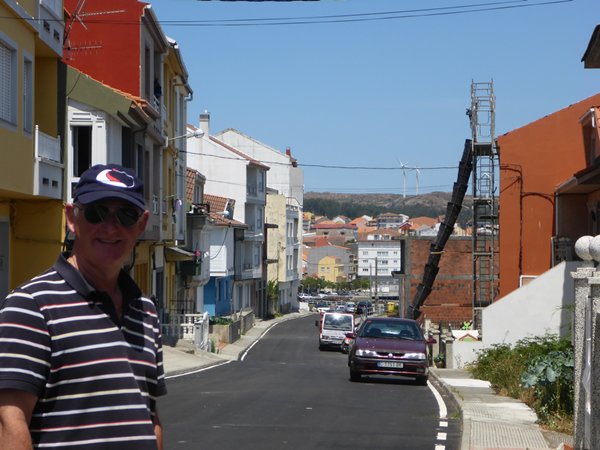Corunna to Corme to Camarinas
43:15.6N 08:57.8W Corunna to Corme
With hand bilge pump fixed we have discovered the black water tank macerator pump needs to be self-priming as it has to suck air before the effluent gets to it and ours is not that kind of pump, so maybe that’s why it has never worked! You say, “But any decent engineer would have told you that”, so why haven’t they I ask. We’ll get it fixed one fine day.
Near to us on the other side of the main pontoon is where little boats, in particular motor pleasure boats, are kept. A grandfather spends time fishing with his grandchildren. The children are crab fishing while he has a couple of lines out over the stern of his boat and is using his hunting knife to lever muscles off the waterline of the pontoon floats. Now that’s resourceful and they might have a nice fruit de mer for supper.
27th June. On this coast the mariner seems to experience either high winds or no wind and fog. When Peter and I left in Autumn of Arun there was not enough wind to make waves and black sharks fins circled threateningly. A cheery fisherman called “Vigo next then?” “No,” we had to say, “home to England.” But today things are different and we are certainly heading in the direction of Vigo.
In the misty early morning we made our way out of friendly vibrant Corunna using bearing lines and the transit of two white towers to our right. As soon as they were in line we turned to head along a bearing north of the Hercules Tower on 290’. Then round a little to the west for the Islas Salidas and then downhill all the way to Corme.
About 100 years ago a fine British Schooner was making her way home when a few days out from the Lizard she was hit by a terrible storm from the North. All her sails were blown out and, presumably for lack of an engine, she was blown under bare poles right across the Biscay and fetched up in Corme, where she rotted away on her own lines.
An English couple next to us in Corunna had a similar experience. They bought their 32 foot yacht in Canada, sailed her to the Azores and proceeded to sail around there in the summer months for a few years. Earlier this year they set sail for the UK and the same happened, but they reduced sail and gave up the idea of the channel in such bad weather and ended up, unscathed, in Corunna, from where they will have another attempt at a home coming later this year.
So despite this granite Iberian coast being known as the Costa del Morte, as indeed it was for many engineless ships in an onshore gale, there are numerous inlets, rias, bays and now harbours and marinas in which desperate mariners can seek safety and enjoy the care and friendliness of the locals as indeed we did.
Now I have always thought Rob to be a mild mannered gentleman, possibly a kinder person than I am, not easily angered by trivial provocations (not all mine), but that changed when the 7th yacht overtook us in the days fickle offering of wind. “Where’s the f…ing wind when you want it?” and “Why won’t the sails set properly Barbs?” I gently reasoned the other yachts were of lighter build than us, and you can bet your bottom dollar their tanks have nothing like the capacity of ours, which are full. To say nothing of the cans of peas and beans. And in which vessel would you rather be caught out in a gale?
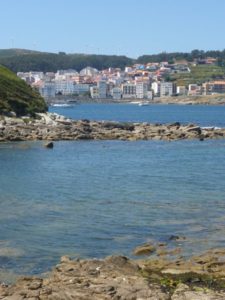
Mercifully we closed Corme and dropped anchor outside the area of viveros, floating muscle farms with vertical anchor chains at each of their four corners, and just off a beautiful sandy beach. 3 metre waves were breaking on the rocks a short distance behind us but we trusted Zoonie’s anchor would hold. We buried it with a quick burst astern after gently reversing to lay the chain along the seafloor. Anchoring is increasingly being frowned upon by environmentalists as the chain effectively loosens all plant life on the seabed when the vessel moves with the changing tide.
A sole wet-suited swimmer crawls right across from the beach behind us to the harbour wall and back twice, as we surge back and forth with the remains of Atlantic rollers heaving gently into the bay.
Choices, choices, Rob says “Either we can pump up the dinghy and row ashore for supper, or stay here, sup on board and open a bottle of champagne to celebrate our first anchorage of the trip?” Well you know what I chose don’t you.
The next morning we pumped up the dinghy and motored in to a patch of sand beside a slipway and as we walked away from the dinghy an elderly local told us, in gesticulations, that the tide would lift the dinghy onto the rocks and we should leave it on the slip. We thanked him and did just that. Phew, lifting the dinghy is ok but with the motor on the transom you can imagine whose side was higher!
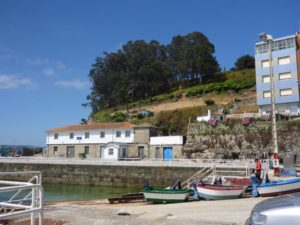
The walk out to the lighthouse on Punta Del Roncudo took about 35 minutes and was welcome exercise. Back in town we had a drink in the harbour side bar and then motored back to Zoonie. The afternoon was spent on the beach, sun-bathing, exploring and generally relaxing.
Today we had a short brisk sail around to Camarinas. It was here last year that along with four other yachts in the Portugal Rally we sought refuge from the gale which lasted 4 days. Under a cloudless blue sky and 32’ of heat it certainly looks different today.
Camarinas revisited
43:07.47N 09:10.70W
Beautiful granite hills rising all around with swathes of pine and eucalyptus trees, sandy beaches and small areas of farming within stonewalled fields. We stayed a day and then thought we would give Finisterre a go. The winds around this coast can quickly change in speed and direction and on the 1st of July the hands of fate decided that was not to be our day. The sea rose and the wind pushed us away from our destination. Big waves stopped Zoonie almost dead in her valiant progress.
“Are you sure you want to go on Rob?” “Yes.” It all started to seem quite dangerous. Although the distance we needed to cover was only 20 miles all the signs were wrong. A strong head wind, increasing in velocity, a rising sea and the inevitable wear on the gear and sails. “Ok maybe not today then” Rob commented and with relief I turned Zoonie around.
Back at anchor behind the harbour wall we were with three other boats. Out of the four, three of us were elderly glass fibre yachts and one was modern. The three older ones of us tended to hug our spot but the newer one slewed around from side to side. Either she was of much lighter build and or she has a lifting keel, either way I’m glad I wasn’t on her.
So we waited for the wind to move north and the barometer to rise. Our next window would be the Sunday after another blow was expected to pass through on the Friday. So we made good use of our time and spent the best part of a day walking to Cabo Villano Faro (lighthouse) a round trip of 8 miles. It is one of the few lighthouses where the keepers have to make their way along a concrete corridor built against the granite hillside to go to work.
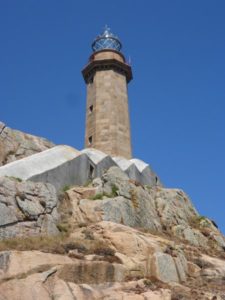
Zetor tractors with wooden trailers waited at the top of the rocks while their owners prized shellfish from the rocks below to sell to local restaurants. Right beside the road to the lighthouse a massive fish farm with security cameras all around was full of round tanks, 20’ or so across, fed with fresh sea-water and oxygen. Different methods of farming the sea from different ages working side by side.
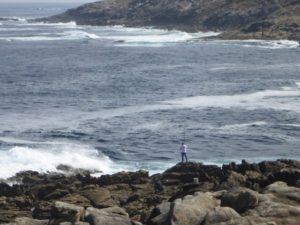
Well the promised wind arrived on the Friday and we stood anchor watch all day as the wind speed rose to 33 knots in the harbour. I can tell you that can get VERY BORING after a while, so at 5.00pm we gave up and went into the marina for another night. At least that way we could get to our favourite restaurant (much visited last year) for a fresh fish supper with local white wine.
The next day the wind was still stubbornly in the south so we thought we’d potter over to Muxia, on the other side of the estuary and in fact on route to the harbour mouth and drop anchor for the night, giving us an early start in the morning.
We set off along with a few others into virtually no wind and chose to motor-sail to Finisterre. As we rounded the headland the wind picked up and here we sit in the harbour, at anchor with it howling from the north at 20 plus knots. Best not go ashore at present, it would be a little irresponsible to leave her unattended till the wind drops and we’d probably get soaked in the dinghy. I tell you sailing can be so frustrating!
